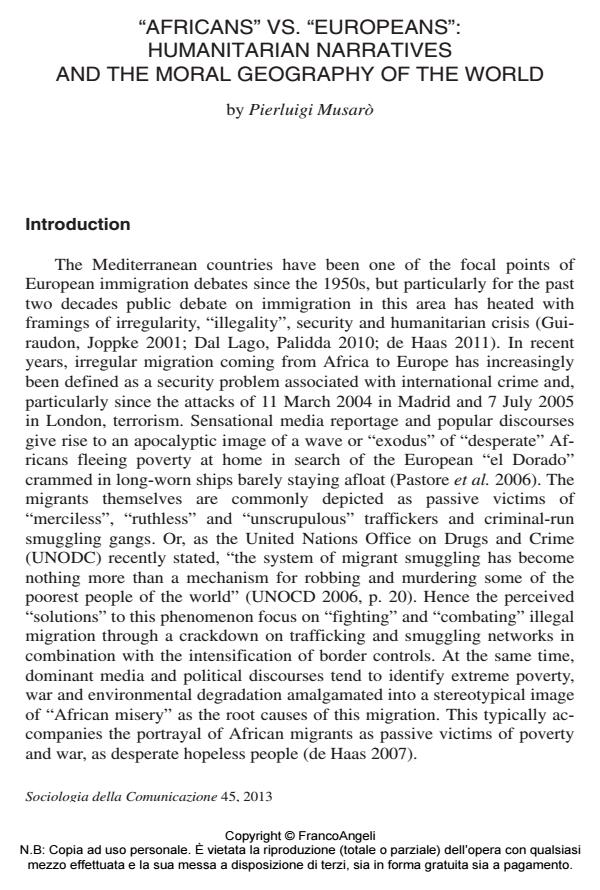"Africans" vs. "europeans": humanitarian narratives and the moral geography of the world
Titolo Rivista SOCIOLOGIA DELLA COMUNICAZIONE
Autori/Curatori Pierluigi Musarò
Anno di pubblicazione 2014 Fascicolo 2013/45
Lingua Italiano Numero pagine 23 P. 37-59 Dimensione file 559 KB
DOI 10.3280/SC2013-045004
Il DOI è il codice a barre della proprietà intellettuale: per saperne di più
clicca qui
Qui sotto puoi vedere in anteprima la prima pagina di questo articolo.
Se questo articolo ti interessa, lo puoi acquistare (e scaricare in formato pdf) seguendo le facili indicazioni per acquistare il download credit. Acquista Download Credits per scaricare questo Articolo in formato PDF

FrancoAngeli è membro della Publishers International Linking Association, Inc (PILA)associazione indipendente e non profit per facilitare (attraverso i servizi tecnologici implementati da CrossRef.org) l’accesso degli studiosi ai contenuti digitali nelle pubblicazioni professionali e scientifiche
Moving from the assumption that borders are not mirror-like reflections of the divisions existing in the physical-cultural landscape but are fabrications people and institutions make to legitimate distinctions between them, the paper begins by identifying discourses and the ways in which humanitarian narratives usually represent Europe and Africa as "imagined meta-communities" and construct borders at imaginary levels. The article focuses on humanitarian organizations’ fundraising and awareness campaigns, the public communication of the European border control agency Frontex, and other public communications, which construct imaginaries of "Africans" and "Europeans" in different contexts through text and visual images. Finally, the paper explores how humanitarian discourse reduces vulnerable and suffering populations to voiceless victims by reifying their condition of victimhood while ignoring their history and muting their words.
Parole chiave:Narrazioni umanitarie, controllo dei confini, diseguaglianza, compassione, migrazione, ONG
- Visual Securitization Alice Massari, pp.135 (ISBN:978-3-030-71142-9)
- Visual Securitization Alice Massari, pp.1 (ISBN:978-3-030-71142-9)
- Contronarrazioni del cambiamento climatico. Diari di ingiustizia climatica tra Dakar e Saint Louis, Senegal Elena Giacomelli, Sarah Walker, in SOCIOLOGIA DELLA COMUNICAZIONE 64/2023 pp.121
DOI: 10.3280/SC2022-064007
Pierluigi Musarò, "Africans" vs. "europeans": humanitarian narratives and the moral geography of the world in "SOCIOLOGIA DELLA COMUNICAZIONE " 45/2013, pp 37-59, DOI: 10.3280/SC2013-045004